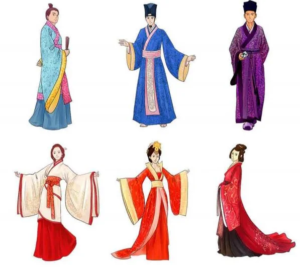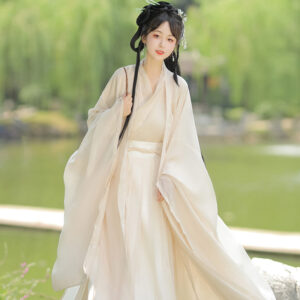

Hanfu from the Ming Dynasty (1368–1644) differed from earlier styles in several significant ways, marking both a return to certain traditional elements and introducing new influences. The Ming Dynasty was a time of cultural revival and innovation after the foreign rule of the Mongol-led Yuan Dynasty (1271–1368). The Han Chinese reclaimed power and sought to restore their traditions, including the Hanfu, as a symbol of Han identity and culture. Here’s a detailed breakdown of how Ming Dynasty Hanfu differed from earlier styles:
1. Restoration of Traditional Hanfu
One of the main differences between Ming Dynasty Hanfu and earlier styles was the deliberate restoration of traditional Hanfu garments that had been diminished or altered during the Mongol rule of the Yuan Dynasty. The Mongols introduced new clothing styles that were different from traditional Han attire, often favoring shorter, tighter-fitting garments better suited for horseback riding and the steppe lifestyle.
With the establishment of the Ming Dynasty, there was a conscious effort to revive the classical elements of Hanfu from earlier dynasties, particularly those from the Han, Tang, and Song periods. This restoration was seen as a way to reassert Han cultural identity. For instance, the Shenyi, a long, flowing robe worn by men, and the Ruqun, a skirt-and-blouse combination worn by women, were brought back as formal wear, symbolizing a return to tradition.
2. Influence of Confucianism and Social Order
The Ming Dynasty was heavily influenced by Confucian ideals, particularly in the structuring of society. This had a profound impact on Hanfu styles, with clear distinctions being made between the clothing of different social classes. Strict dress codes were enforced, and specific styles, colors, and accessories were designated for different ranks and occasions.
- Scholarly and Official Dress: Scholar-officials, who formed the backbone of the Ming government, wore clothing that reflected their status and adherence to Confucian values. Officials wore round-collared robes with wide sleeves, known as Pao, which were formal and dignified. These robes were often embroidered with rank badges, called buzi, which displayed specific animal or bird motifs representing their official position.
- Commoners’ Clothing: Common people, in contrast, were restricted to simpler fabrics and more modest designs. The Ming government prohibited the lower classes from wearing bright colors or intricate patterns, reserving such luxury for the elite. Commoners typically wore plain, practical clothing made from cotton, hemp, or wool, depending on the region.
The strict codification of clothing based on social status was more rigid than in earlier dynasties, reinforcing Confucian ideals of hierarchy and order.
3. Changes in Women’s Hanfu
Ming Dynasty women’s Hanfu styles saw significant changes from earlier periods, reflecting both a revival of traditional forms and some innovations unique to the Ming.
- High-Waisted Skirts (Mǎmiànqun): One of the most notable developments in women’s clothing during the Ming period was the widespread popularity of the Mǎmiànqun (马面裙), or “horse-face skirt.” This was a pleated skirt with straight panels on the front and back, designed to create a more structured, dignified appearance. The Mǎmiànqun had a high waist and was often paired with a long-sleeved blouse (Shan) that created a layered look. This style was distinct from earlier periods, where skirts typically sat lower on the waist and were more flowing.
- More Structured Silhouettes: In general, Ming Dynasty women’s Hanfu emphasized a more structured, formal silhouette than earlier dynasties. While Tang and Song Dynasty clothing tended to be more relaxed and flowing, Ming Dynasty women’s clothing was more defined, with fitted bodices, high waists, and flared skirts. This shift reflected changing ideals of femininity, which emphasized modesty, grace, and order in line with Confucian values.
- Embroidered Patterns and Motifs: Women’s Hanfu in the Ming period also featured more elaborate embroidery, with intricate floral designs, auspicious symbols, and animal motifs becoming more common. Unlike the relatively plain styles of earlier periods like the Song, Ming women’s clothing often featured colorful, decorative patterns that signified prosperity and good fortune.
4. Introduction of the Beizi
The Beizi (褙子), a long, loose-fitting outer garment, became more prominent during the Ming Dynasty, particularly for women. While the Beizi had existed in earlier periods, it became an essential part of Ming Dynasty fashion for both formal and casual occasions.
The Beizi had long, wide sleeves and often extended down to the knees or lower. It could be worn open, revealing the garments underneath, or belted at the waist for a more structured look. The garment’s versatility made it popular among women, and it was often decorated with embroidered patterns or lined with fur for warmth in the winter. This layered style allowed for greater flexibility and elegance in dressing, setting Ming women’s fashion apart from earlier dynasties.
5. Court and Imperial Clothing
Ming Dynasty court clothing was among the most elaborate and strictly regulated in Chinese history. The emperor, his family, and high-ranking officials had the privilege of wearing intricate, symbolic designs that were meant to emphasize their authority and connection to Heaven.
- Dragon Robes (Longpao): The Longpao (龙袍), or dragon robe, was the most iconic piece of imperial clothing in the Ming Dynasty. Worn by the emperor and princes, these robes were typically bright yellow and embroidered with dragons, clouds, and other celestial symbols. The dragons had five claws, symbolizing the emperor’s divine right to rule, while lesser nobles wore robes with four-clawed dragons.
- Fengguan and Xiapei: Women of the imperial court wore Fengguan (phoenix crowns), elaborate headdresses adorned with gold, pearls, and jade, along with Xiapei, embroidered silk sashes worn over formal dresses. The use of phoenix motifs symbolized feminine power and virtue, and these garments were reserved for the highest-ranking women, including the empress and imperial concubines.
The grandeur of court clothing in the Ming Dynasty far surpassed that of previous dynasties, particularly in terms of the symbolic use of dragons, phoenixes, and heavenly motifs to reflect the power and divinity of the imperial family.
6. Textile Innovation and Decoration
The Ming Dynasty was an era of innovation in textile production, and this greatly influenced Hanfu styles. Advances in silk weaving and embroidery techniques allowed for more complex and detailed patterns to be incorporated into clothing. Garments were often richly decorated with auspicious symbols, such as peonies (representing wealth), lotus flowers (symbolizing purity), and cranes (for longevity).
Kesi silk tapestry, a technique that involved weaving intricate designs into the fabric itself, became a highly prized form of decoration during the Ming Dynasty. This technique allowed for vibrant, multi-colored patterns that were more durable and visually striking than embroidery alone. The result was a more luxurious and ornate Hanfu, particularly for the upper classes.
7. Regulated Colors and Patterns
The Ming government instituted strict regulations on the colors and patterns that could be worn by different social classes, professions, and ranks. These regulations were much more specific than in earlier dynasties and were intended to reinforce social order and hierarchy.
- Colors: Certain colors were restricted to specific social ranks. For example, only the emperor could wear bright yellow, while red and purple were reserved for high-ranking officials and members of the imperial family. Commoners were generally limited to wearing darker, more muted colors like blue, black, and gray.
- Patterns: The use of certain patterns, particularly those involving dragons, phoenixes, and other auspicious symbols, was also tightly controlled. Only the emperor could wear a five-clawed dragon, while lower-ranked nobles wore four-clawed dragons. The use of other symbols, such as cranes or tigers, was similarly regulated to indicate official rank or profession.
8. Military Hanfu
Ming Dynasty military uniforms differed significantly from civilian Hanfu, reflecting the practical needs of soldiers while maintaining traditional elements. Soldiers wore Zhanfu, a type of armor that incorporated both metal and fabric, designed to be flexible for battle while offering protection. Military Hanfu also featured tighter-fitting trousers and sleeves to allow for easier movement.
Higher-ranking military officials had more elaborate uniforms, often incorporating embroidered symbols of their rank and achievements. Unlike the more restrained, civilian styles, military Hanfu allowed for some display of strength and status through the use of bold patterns and colors.
Conclusion: Ming Dynasty Hanfu as a Blend of Tradition and Innovation
Ming Dynasty Hanfu represented both a revival of traditional Han clothing styles and the introduction of new elements that reflected the social, political, and cultural changes of the time. The emphasis on Confucian values, strict social hierarchy, and textile innovation all contributed to the distinctiveness of Ming Hanfu, making it one of the most structured and regulated periods in the history of Chinese clothing. The fusion of tradition with the unique innovations of the era continues to influence modern Hanfu revival movements, where the elegance and formality of Ming Dynasty styles are often celebrated.
Share this post
Recent Posts


What were the key features of Hanfu during the Tang Dynasty?

How did Hanfu styles vary during different Chinese dynasties?

What accessories are typically worn with Hanfu?

How do you choose the right Hanfu for different seasons?

Newsletter
Popular Categories
Related Post
Sed aliquam, tortor et sodales malesuada, lorem leo luctus tellus, quis interdum eros nibh in nunc. Cras dignissim malesuada, lorem leo luctus

What are the winter hanfu called?

What were the key features of Hanfu during the Tang Dynasty?

How did Hanfu styles vary during different Chinese dynasties?


